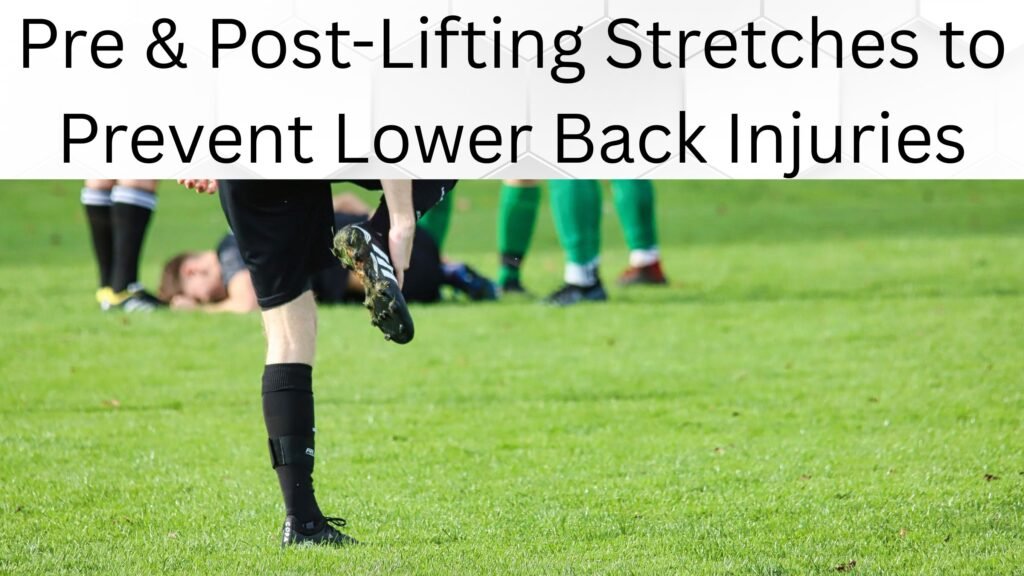Weightlifting strengthens muscles, but it also puts stress on the lower back. Without proper stretching, tight muscles and improper movement patterns increase the risk of strains and injuries. A structured pre- and post-lifting stretching routine keeps the lower back flexible, reduces stiffness, and enhances recovery.

Why Stretching Matters for Lifters
Lifting heavy weights requires a strong, stable lower back. However, tight hamstrings, hip flexors, and spinal muscles limit mobility, forcing the lower back to compensate. Over time, this leads to poor form, muscle imbalances, and pain. Stretching before lifting prepares the muscles for movement, while post-lifting stretches aid recovery and prevent stiffness.
Pre-Lifting Stretches: Loosen Up Before Heavy Lifts
Dynamic stretching before weightlifting activates muscles and increases blood flow. These movements prepare the lower back and surrounding muscles for the stress of lifting.
1. Cat-Cow Stretch
- Get on all fours with hands under shoulders and knees under hips.
- Inhale, arch your back, and look up.
- Exhale, round your back, and tuck your chin.
- Repeat for 30 seconds to improve spinal mobility.
2. Hip Flexor Stretch
- Kneel with one foot forward in a lunge position.
- Shift your weight forward to stretch the hip flexor.
- Hold for 20 seconds per side to loosen tight hips.
3. Standing Hamstring Stretch
- Stand with one foot on a bench or low surface.
- Keep your leg straight and lean forward slightly.
- Hold for 20 seconds per leg to prevent hamstring tightness.
4. Spinal Twists
- Stand with feet shoulder-width apart.
- Rotate your torso side to side with controlled motion.
- Perform for 30 seconds to activate the obliques and lower back muscles.
5. Glute Bridge Activation
- Lie on your back with knees bent and feet flat on the floor.
- Lift your hips until your body forms a straight line.
- Hold for a second, then lower back down.
- Repeat 10 times to activate the glutes and support the lower back.
Post-Lifting Stretches: Aid Recovery & Prevent Stiffness
After lifting, static stretching helps release tension, improve flexibility, and reduce post-workout soreness.
1. Child’s Pose
- Kneel on the floor with toes together and knees apart.
- Extend your arms forward and lower your chest.
- Hold for 30 seconds to stretch the lower back and hips.
2. Seated Forward Fold
- Sit with legs extended straight.
- Reach for your toes while keeping your back straight.
- Hold for 30 seconds to stretch the hamstrings and lower back.
3. Supine Spinal Twist
- Lie on your back with arms outstretched.
- Bring one knee to your chest and twist it across your body.
- Hold for 20 seconds per side to release spinal tension.
4. Piriformis Stretch
- Sit with one ankle over the opposite knee.
- Lean forward slightly to stretch the glutes.
- Hold for 20 seconds per side to relieve lower back pressure.
5. Cobra Stretch
- Lie on your stomach with hands under shoulders.
- Press up, lifting your chest while keeping hips down.
- Hold for 20 seconds to stretch the lower back and improve spinal mobility.
Additional Tips to Protect Your Lower Back
- Warm up properly before lifting to activate key muscles.
- Engage your core to stabilize the spine during lifts.
- Maintain proper form to avoid excessive lower back strain.
- Gradually increase weights instead of overloading muscles too quickly.
- Listen to your body and avoid pushing through pain.
A strong, mobile lower back supports better lifting performance and prevents injuries. Make stretching a habit before and after your workouts to keep your lower back healthy and pain-free.